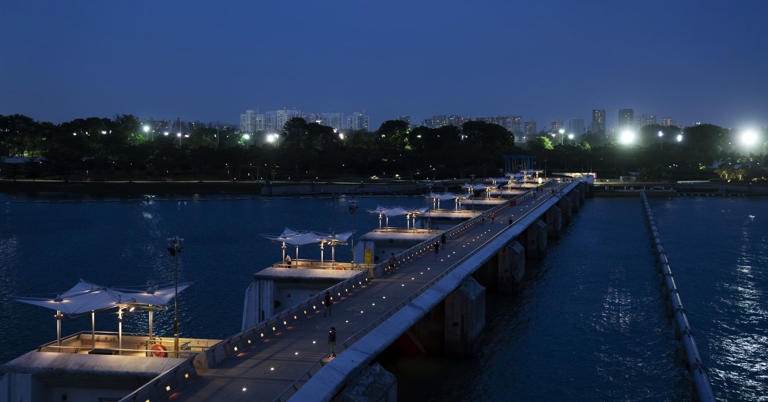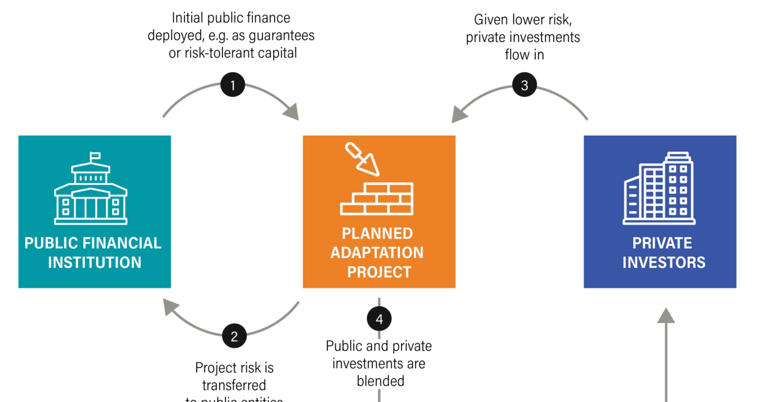Story by Nyshka Chandran • CNBC - Yesterday
Singapore's government has committed public funds to help the country deal with the detrimental impact of climate change, which include droughts, floods and water scarcity.
But experts say diverse sources of capital are also needed from private banks, insurance players and financial markets.
Corporate green bonds, catastrophe bonds and blended finance projects are all ways to boost private sector involvement in adaptation finance.

Singapore's government has pledged $74.15 billion over the next century to safeguard the city against rising temperatures and floodwaters.© Provided by CNBC
Singapore, a tiny city-state with an import-dependent economy, is especially vulnerable to rising sea levels, heat waves and other adverse effects of climate change.
That's why the government has pledged 100 billion Singapore dollars ($74.15 billion) over the next century to help the country withstand and minimize damages from greenhouse gas emissions. This is an adaptive approach that differs from mitigative measures such as carbon pricing and renewables.
Experts warn, however, that public funds alone aren't enough for Singapore's infrastructure and economy to adjust to higher temperatures. Private sources of capital from banks, insurance players and financial markets are also needed, in addition to blended finance projects involving public-private partnerships, they say.
The problem isn't unique to Singapore.
Around the globe, financing for climate adaptation has traditionally lagged behind mitigation investments that are focused on slowing or stopping the rise in fossil fuel emissions.
That's primarily due to widespread perception that adaptation and resilience projects don't really generate revenue, according to Xinying Tok, head of Southeast Asia at environmental consultancy Carbon Trust.
The lack of understanding about adaptation and resilience leads to mispricing across financial solutions, whether it's in investment, credit or insurance, she continued.
Singapore's climate challenges
In 2019, Singapore prime minister Lee Hsien Loong said climate change was a matter of "life and death" for the city-state.
Sea levels are projected to rise by 1 meter by 2100 but there's a risk they could go up to 4 or 5 meters higher than current levels depending on storm surges, land subsidence and other factors, according to authorities.
That kind of increase could "potentially flood one-third of Singapore," Grace Fu, the minister for sustainability and the environment, has said.
Climate adaptation projects include constructing resilient water systems to manage scarcity during droughts and building barriers like sea walls to protect against rising sea levels, explained Emirhan Ilhan, assistant professor at the National University of Singapore Business School and research affiliate at the Sustainable and Green Finance Institute.
As such ventures improve existing infrastructure, they are often financed with public sources but "collaboration with the private sector is also necessary since no government can shoulder the costs of these projects in its entirety," he said.
"Although a sense of urgency to tackle adaptation has been widely communicated from the top down in the City State, it has not yet clearly articulated a role for the private sector and the market in adaptation," said researchers of a report from the Singapore Green Finance Centre (SGFC) in February.
An initiative of London's Imperial College and Singapore Management University, SGFC was launched in 2020 to advance climate financing solutions.
Mobilizing private capital
1. Catastrophe bonds
Catastrophe bonds — designed to raise money for companies in the insurance industry in the event of a natural disaster — are a widely touted mechanism for climate adaptation.
The Monetary Authority of Singapore, the country's financial regulator and de facto central bank, has been supporting the sector through its Insurance Linked Securities Grant Scheme, which helps fund upfront costs to issue these debt instruments.
The program produced 23 catastrophe bonds as of late 2022 and has been extended until the end of 2025.
2. Green bonds
Green bonds are another option but so far, the space is dominated by public-sector activity and mostly focuses on mitigating climate change through energy efficiency, clean transportation and sustainable water management.
The corporate green bond market, which lags behind government issuances, also leans heavily toward climate mitigation measures. In 2020, Vena Energy became the first Singapore-based company to issue green bonds in U.S. dollars with a $325 million five-year green bond aimed at refinancing existing corporate loans for green projects.

De-risking adaptation opportunities© Provided by CNBC
When the risk-return trade-off isn't perceived as sufficient for private investors, Singapore must create the right incentives through subsidies or by reducing burdens like taxes, or regulation, said Ilhan.
"The good news is that Singapore is very good at creating predictable and enforceable regulation —therefore, there is reason to be optimistic," he said.
'Blended financing'
Blended finance, or public-private partnerships, will be critical for infrastructure projects like climate-proofing airports, coastal protection plans and developing local food production.
In a report published last month, the World Resources Institute (WRI) said guarantees, co-financing or other methods of risk reduction from public players and development finance institutions can help attract private capital.
Another way to increase blended financing is to introduce more risk-tolerant capital structures, the report said, citing Lightsmith Climate Resilience as an example of a private equity fund that invests in solutions to the effects of climate change.
"The fund uses donor capital to create a risk-absorbing junior layer, which carries a higher potential for loss and helps reduce the level of risk for subsequent investors" — that enables Lightsmith to attract an estimated $3.30 of direct commercial investment for every $1 contributed by public financial institutions, the WRI report explained.
Going forward, Tok from Carbon Trust recommends greater market coordination.
Since pricing physical risks is hard, market players in Singapore could benefit from "shared modelling support that allows the potential costs to a range of economic activities to be compared to adaptation costs," she concluded.
No comments:
Post a Comment